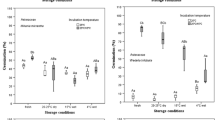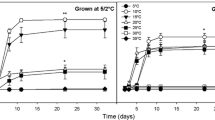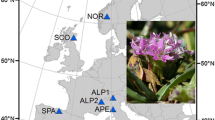Abstract
Effects on seed germination of temperatures ranging from −2 C to +29 C were tested inDioscorea nipponica, D. tokoro, D. japonica, D. tenuipes, D. septemloba andD. quinqueloba which orginate in the temperate zone; they are distributed from northern cold areas to southern warm areas approximately in this order in Japan. After water imbibition of these seeds, chilling induced full germination, and high temperatures over 23 C induced a secondary dormancy, but sensitivities to the chilling and to the high temperatures differed with species. Cold-climate species germinated rapidly at higher temperatures after a short-term chilling or even without chilling, whereas warm-climate species required chilling of a rather long period for germination; thus, among 6 species tested, favourable temperatures for germination and climatic temperatures of distribution area were conversely correlated.
Seeds ofD. tokoro andD. japonica collected from several populations grown in different climates were also tested for germination at 11 to 29 C; seeds from warm climates germinated rather slowly compared to seeds from cold climates.
These inte- and intra-specific adaptation manners in the temperature members of the genusDioscorea are entirely different from those of many other plant genera reported by some workers.
Similar content being viewed by others
References
Ayensu, E.S.. 1972. Anatomy of the monocotyledons.In: C.R. Metcalfe, ed., VI. Dioscoreales p. 1–182. Oxford Univ. Press, London.
Burkill, I.H.. 1960. The organography and the evolution of Dioscoreaceae, the family of yams. J. Linn. Soc. Bot.56; 319–412.
Dale, E. 1901. On the origin, development, and morphological nature of the aerial tubers inDioscorea sativa Linn. Ann. Bot.15: 491–501.
Haasis, F.W. andA.C. Thrupp. 1931. Temperature relations of lodge-pole pine seeds germination. Ecology12: 728–744.
Hatusima, S.. 1961. On a fewDioscorea from Ryukyus. J. Jap. Bot.36: 236–238 (in Japanese).
— 1971. Flora of Ryukyus. Okinawa Seibutu Kyoiku Kenkyukai, Naha (in Japanese).
Iwao, T. 1980. Seed germination of some JapaneseDioscorea species. Shushi Seitai12: 12–14 (in Japanese).
McNaughton, S.J. 1966. Ecotypic function in theTypha community-type. Ecol. Monogr.36: 297–325.
Nakano, H. andS. Kinoshita. 1942. Über die Entstehungsbedingungen der Luftknölchen vonDioscorea batatas und ihre characteristische Ruheperiode. Jap. J. Bot.12: 237–249.
Nikolaeva, M.G.. 1969. Physiology in deep dormancy in seeds. Israel Program for Scientific Translations, Jerusalem.
Ohwi, J.. 1953. Flora of Japan. Shibundo, Tokyo.
Okagami, N.. 1978. Dormancy inDioscorea; Sprouting promotion by protein synthesis inhibitors in bulbils and rhizomes. Plant Cell Physiol.19: 221–227.
— 1979. Dormancy in bulbils of several herbaceous plants: Effects of photoperiod, light, temperature, oxygen and gibberellic acid. Bot. Mag. Tokyo92: 39–58.
— andM. Kawai. 1977. Dormancy inDioscorea: Gibberellin-induced inhibition and promotion in seed germination ofD. tokoro andD. tenuipes in relation to light quality. Plant Physiol.60: 360–362.
— andM. Nagao. 1971. Gibberellin-induced dormancy in bulbils ofDioscorea. Planta101: 91–94.
Okuyama, H.. 1977. A handbook for plant collectors, 2nd ed. Yasaka Shobo, Tokyo (in Japanese).
Plain, D. andI.H. Burkill. 1936. An account of the genusDioscorea in the East. Ann. Roy. Bot. Gdns Calcutta14: 1–528.
Sterns, F. andJ. Olson. 1958. Interaction of photoperiod and temperature affecting germination inTsuga canadensis. Amer. J. Bot.45: 53–58.
Takeuchi, Y., T. Iwao andA. Akahori. 1970. Chromosome numbers of some JapaneseDioscorea species. Acta Phytotax. Geobot.24: 168–173.
Tanno, N. and N. Okagami. 1974. Dormancy in bulbils: On several species of the genusDioscorea ranging in different regions. Abst. Paper. Jap. Soc. Environ. Control. Biol. 12th Ann. Meeting p. 70–73 (in Japanese).
Thompson, P.A.. 1968. Germination of Caryophyllaceae at low temperatures in relation to geographical distribution. Nature217: 1156–1157.
—. 1970. Characterization of the germination response to temperature of species and ecotypes. Nature225: 827–831.
Author information
Authors and Affiliations
Rights and permissions
About this article
Cite this article
Okagami, N., Kawai, M. Dormancy inDioscorea: Differences of temperature responses in seed germination among six Japanese species. Bot Mag Tokyo 95, 155–166 (1982). https://doi.org/10.1007/BF02488582
Received:
Issue Date:
DOI: https://doi.org/10.1007/BF02488582




